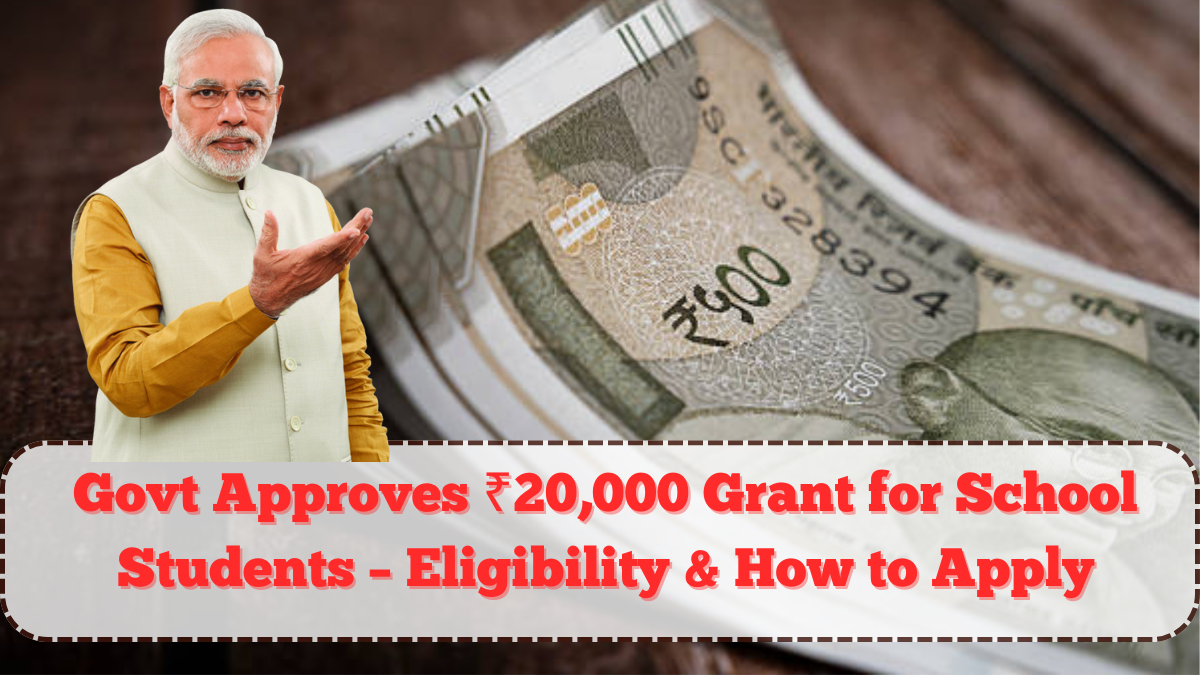In a landmark move aimed at reducing educational inequality, the Indian government has officially launched a new education scheme that provides a ₹20,000 grant to eligible school students in 2025. This student support initiative is part of a broader national effort to uplift economically weaker students and ensure access to basic academic needs.
With rising costs of uniforms, books, tuition, and digital access, the government grant comes as a much-needed relief for thousands of families. Whether your child is in primary, middle, or secondary school, this scheme could provide direct financial support to keep them enrolled and motivated.
Let’s break down who is eligible, how the scheme works, and how to apply for the ₹20,000 school grant in 2025.

What Is the ₹20,000 Government Grant for Students?
The government grant offers a one-time ₹20,000 financial aid to school students from low-income families across India. It is part of the 2025 Central Education Fund and is designed to help students cover:
-
Tuition fees and exam charges
-
Books, stationery, and uniforms
-
Online learning devices or internet data
-
Transportation or hostel fees (for outstation students)
This education scheme targets students who are currently enrolled in government schools or government-aided private institutions and belong to families facing financial hardships.
Eligibility Criteria for the ₹20,000 Student Support Grant
To qualify for this student support grant, students must meet the following criteria:
-
Must be enrolled in classes 6 to 12 in a recognized government or government-aided school
-
Family income must be less than ₹2.5 lakh per annum
-
Must not be receiving benefits from similar Central or State schemes
-
Should have 75% or higher attendance in the previous academic year
-
Must have a bank account linked with Aadhaar
Students with disabilities, girls, and those from SC/ST/OBC/EWS categories will be given preference under this education scheme.
How to Apply for the ₹20,000 School Grant in 2025
Eligible students or their guardians can apply through the following steps:
-
Visit the Official Portal: The Ministry of Education will launch a dedicated website for online registration.
-
Fill the Application Form: Enter student details, school information, income certificate, Aadhaar, and bank account details.
-
Upload Documents: Submit scanned copies of:
-
School ID card or Bonafide certificate
-
Aadhaar card
-
Income proof
-
Attendance report (if required)
-
-
Submit and Track Status: Once submitted, an acknowledgment ID will be generated for tracking.
Offline application forms will also be available at block education offices for families without internet access.
Disbursement and Timeline
The ₹20,000 grant will be directly transferred to the student’s or parent’s Aadhaar-linked bank account through DBT (Direct Benefit Transfer).
Here’s a timeline breakdown:
| Activity | Date Range (Tentative) |
|---|---|
| Online Application Opens | July 15, 2025 |
| Application Deadline | August 31, 2025 |
| Verification & Approval | September 2025 |
| Fund Disbursement Begins | October 2025 onwards |
This ensures that students receive the aid in time for the next academic session or essential mid-year purchases.
FAQs
Who is eligible for the ₹20,000 student grant in 2025?
Students from classes 6 to 12 enrolled in government or aided schools with a family income below ₹2.5 lakh annually are eligible under this education scheme.
Can private school students apply for the grant?
Only those studying in government-aided private schools may qualify. Fully private, unaided institutions are excluded from this government grant.
Is there a last date to apply for this scheme?
Yes. Applications must be submitted before August 31, 2025 to be considered for the ₹20,000 student support benefit.
How will the ₹20,000 be transferred to students?
The amount will be directly credited to the Aadhaar-linked bank account of the student or guardian via DBT.
Do I need to submit documents offline as well?
Only if you are applying through the offline process at your local education office. Online applicants can upload all documents digitally.
Click here to know more.
